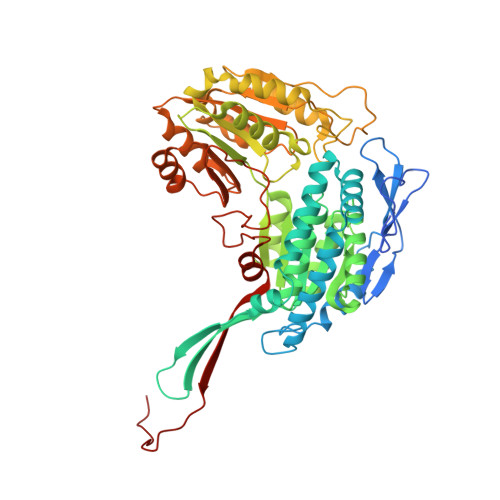Structural and Biochemical Characterization of Aldehyde Dehydrogenase 12, the Last Enzyme of Proline Catabolism in Plants.
Korasick, D.A., Koncitikova, R., Kopecna, M., Hajkova, E., Vigouroux, A., Morera, S., Becker, D.F., Sebela, M., Tanner, J.J., Kopecny, D.(2019) J Mol Biology 431: 576-592
- PubMed: 30580036
- DOI: https://doi.org/10.1016/j.jmb.2018.12.010
- Primary Citation of Related Structures:
6D97 - PubMed Abstract:
Heterokonts, Alveolata protists, green algae from Charophyta and Chlorophyta divisions, and all Embryophyta plants possess an aldehyde dehydrogenase (ALDH) gene named ALDH12. Here, we provide a biochemical characterization of two ALDH12 family members from the lower plant Physcomitrella patens and higher plant Zea mays. We show that ALDH12 encodes an NAD + -dependent glutamate γ-semialdehyde dehydrogenase (GSALDH), which irreversibly converts glutamate γ-semialdehyde (GSAL), a mitochondrial intermediate of the proline and arginine catabolism, to glutamate. Sedimentation equilibrium and small-angle X-ray scattering analyses reveal that in solution both plant GSALDHs exist as equilibrium between a domain-swapped dimer and the dimer-of-dimers tetramer. Plant GSALDHs share very low-sequence identity with bacterial, fungal, and animal GSALDHs (classified as ALDH4), which are the closest related ALDH superfamily members. Nevertheless, the crystal structure of ZmALDH12 at 2.2-Å resolution shows that nearly all key residues involved in the recognition of GSAL are identical to those in ALDH4, indicating a close functional relationship with ALDH4. Phylogenetic analysis suggests that the transition from ALDH4 to ALDH12 occurred during the evolution of the endosymbiotic plant ancestor, prior to the evolution of green algae and land plants. Finally, ALDH12 expression in maize and moss is downregulated in response to salt and drought stresses, possibly to maintain proline levels. Taken together, these results provide molecular insight into the biological roles of the plant ALDH12 family.
- Department of Biochemistry, University of Missouri, Columbia, MO 65211, USA.
Organizational Affiliation:

















